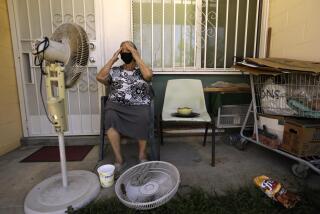Portable Air Conditioner Is a Cool Way to Save Money
- Share via
Question: I have central air-conditioning, but I thought about also using a portable, roll-about air conditioner in various rooms that need extra cooling at times. Does this make sense and are they efficient?
Answer: It makes a lot of sense from money-saving and comfort standpoints. Even though I have a super-efficient central air conditioner at my home, I also use a portable unit. I run it in my study during the daytime and then roll it to my bedroom at night.
Nearly every house has a room, or even an entire floor, which never gets cool enough while the rest of the house is comfortable. Instead of setting the central air conditioner thermostat lower to cool those problem rooms, use a portable unit in them. Overall, this will save a lot of electricity.
For example, a portable unit is often used in the kitchen while cooking. After dinner, roll it into the living room while you’re watching TV. At bedtime, move it to the bedroom that is always a little too warm. I set mine on the low, quiet speed at night so it more effectively dehumidifies the air.
Portable units are small, lightweight (as low as 36 pounds) and mounted on casters for rolling from room to room. Most models also have built-in handles that allow for easier carrying up stairs.
They all operate on standard 110-volt house power, so you can plug them into any electrical wall outlet.
Many units are tall (about 25 inches) and narrow (about 11 inches) so they fit nicely in a corner. You can direct the cooled air to blow in one direction, if you are sitting in a nearby chair, or in several directions.
For the best air distribution, pick a model that has oscillating louvers.
Portable models work somewhat like a super-efficient window air conditioner, except the entire unit is indoors. The heat that is drawn out of the indoor air is exhausted outdoors through a flexible clothes dryer-type of duct.
All of the models come with an adjustable duct-adapter plate that fits in any window. You just open the window, move out the adjustable slides and close the window on the plate’s foam seals.
It takes only about one minute for me to move mine from my study and have it running in the bedroom.
The newer models have automatic digital controls for the fan speed, cooling output and temperature. As it is cooling the air, moisture is condensed out to reduce the humidity level for better comfort. This water is collected in a small water drawer that you slip out and empty once a day.
The most efficient, powerful models have a separate condenser unit that you place outside the window. It is connected to the quiet indoor unit with a long, thin hose.
Write for (or download at https://www.dulley.com) Update Bulletin No. 704, a buyer’s guide of nine manufacturers (25 models) of portable air conditioners listing efficiencies, cooling outputs, sizes, features, prices and a cost-to-operate chart. Please include $3 and a business-size, self-addressed, stamped envelope and mail to James Dulley, Los Angeles Times, 6906 Royalgreen Drive, Cincinnati, OH 45244.
Air Barrier Film Wrap Shouldn’t Trap Moisture
Q: We are having a home built. Our architect says the house should be wrapped with an air barrier film. The builder says an air barrier will trap moisture inside the walls. Who is correct?
A: In general, it is a good idea to wrap the entire exterior surface of the house with air barrier film before the exterior finish is applied. It will reduce air leakage through the walls.
Most air barrier materials allow moisture vapor to pass through them so that moisture is not trapped.
Check with your builder about any specific reasons using film would cause moisture problems.
Keeping Cooler Air Under House Makes More Sense
Q: I have a single-story house with a crawl space below. I thought it would be good to run a small duct from the crawl space to the attic. I would use a fan to blow the air up to the attic to cool it. Make sense?
A: Actually that would not be a very good idea from an energy standpoint.
Most of the heat entering your house from the attic is radiant heat from the hot roof, so cooling the attic air will not help a lot.
Also, leaving the cooler air underneath your house will help keep the floors cooler and more comfortable.
The electricity used to run the fan would offset any slight benefit you would get from installing the duct.
*
Take an online tour of James Dulley’s house and see the money-saving improvements and products that he tests. There are nearly 100 pictures with links to the various columns that describe the improvements and products. Go to www.dulley.com/house/ on the Internet.
More to Read
Inside the business of entertainment
The Wide Shot brings you news, analysis and insights on everything from streaming wars to production — and what it all means for the future.
You may occasionally receive promotional content from the Los Angeles Times.









